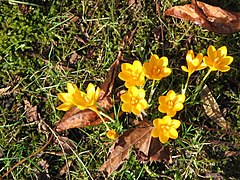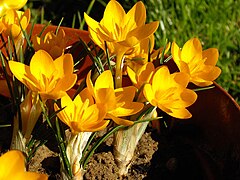| Crocus ancyrensis | |
|---|---|

| |
| Scientific classification | |
| Kingdom: | Plantae |
| Clade: | Tracheophytes |
| Clade: | Angiosperms |
| Clade: | Monocots |
| Order: | Asparagales |
| Family: | Iridaceae |
| Genus: | Crocus |
| Species: | C. ancyrensis |
| Binomial name | |
| Crocus ancyrensis (Herb.) Maw | |
| Synonyms | |
| |
Crocus ancyrensis, sometimes known as the Ankara crocus, (Turkish: Ankara çiğdemi) is a species of flowering plant in the family Iridaceae. It is endemic to North and Central Turkey. It was named ancyrensis as it was first discovered in Ankara.
Description
Crocus ancyrensis is a herbaceous perennial geophyte growing from a corm. Plants grow 4 to 6 inches tall. The corms are oval shaped with fibrous reticulated tunics. The small flowers are 1 inch long and 0.5 ince wide are orange-yellow with orange-red stigmas. The flowers have bright yellow throats and typically each corm produce two or three flowers. Each corm has three or four leaves which appear during flowering.
Habitat
The plant commonly flowers in the months of February to April, and is found growing at 1000–1600 meters in elevation. It commonly grows near rocks, bushes and pines. Its corm, rich in sugar and starch, is edible; it has been a common staple in Anatolia.
Cultivation
Crocus ancyrensis 'Golden Bunch' is a cultivar that was selected for its greater number of flowers than the typical species, with up to ten flowers per corm. It is one of the earliest yellows to bloom. It is winter hardy in USDA zones 3 through 8.
Gallery
References
- ^ "Crocus ancyrensis (Herb.) Maw". Plants of the World Online. The Trustees of the Royal Botanic Gardens, Kew. n.d. Retrieved November 30, 2024.
- BSBI List 2007 (xls). Botanical Society of Britain and Ireland. Archived from the original (xls) on 2015-06-26. Retrieved 2014-10-17.
- "Crocus ancyrensis (Herb.) Maw". Catalogue of Life. Species 2000. n.d. Retrieved November 30, 2024.
- "Crocus ancyrensis". Kew World Checklist of Selected Plant Families. Retrieved 2019-03-27.
- ^ "Ankara Çiğdemi (Crocus ancyrensis)" (in Turkish). Atılım Üniversitesi. Retrieved 2019-03-27.
- ^ Armitage, Allan M. (2008-05-01). Herbaceous Perennial Plants: A Treatise on their Identification, Culture, and Garden Attributes (3rd ed.). Cool Springs Press. ISBN 978-1-61058-380-0.
- ^ Jelitto, Leo (1990). Hardy herbaceous perennials. Wilhelm Schacht, Michael E. Epp, John Philip Baumgardt, Alfred Fessler. Portland, Or.: Timber Press. p. 168. ISBN 0-88192-159-9. OCLC 20012412.
- Füsun EHTUĞ. "Baharın Müjdecisi: Çiğdem (Crocus) ya da AN.TAH.âUMâAR Hititler Devri Anadolu Florasına Küçük Bir Katkı" (in Turkish). Turkish Academy of Sciences Journal of Archaeology. Archived from the original on 2019-03-27. Retrieved 2019-03-27.
- "Ankara Çiğdemi ve Çiçek Müzesi" (in Turkish). Hürriyet. 2012-08-07. Retrieved 2019-03-27.
- Iwona Kaliszewska and Iwona Kołodziejska-Degórska (2015-08-11). "The social context of wild leafy vegetables uses in Shiri, Daghestan". Journal of Ethnobiology and Ethnomedicine. 11. NCBI: 63. doi:10.1186/s13002-015-0047-x. PMC 4542102. PMID 26260575.
| Taxon identifiers | |
|---|---|
| Crocus ancyrensis |
|
| Crocus reticulatus var. ancyrensis | |
This Iridaceae article is a stub. You can help Misplaced Pages by expanding it. |


